To cite this article: Paquette, Lucy. “A Closer Look at Tissot’s “Embarkation at Calais”.” The Hammock. https://thehammocknovel.wordpress.com/2019/05/15/a-closer-look-at-tissots-embarkation-at-calais/. <Date viewed.>
James Tissot began a follow-up series to his 1883-85 series of large-scale paintings, La Femme à Paris (The Parisian Woman), to be called L’Etrangère (The Foreign Woman), but he only completed two canvases. The first, L’Esthétique (The Aesthetic Woman, or In the Louvre, 1883-1885), entered the renowned Pre-Raphaelite and Victorian art collection of the Museo de Arte de Ponce, Puerto Rico in 1962.
The other, La Voyageuse (The Embarkation at Calais, or The Traveller, 1883-1885), is in the collection of the Koninklijk Museum voor Schone Kunsten (The Royal Museum of Fine Arts), Antwerp, and I was able to view it a few weeks ago. It is a large picture, measuring 146.5 by 102 by 1.7 cm (57.7 by 40.2 by .7 in.), and it is known there as The Embarkation at Calais.
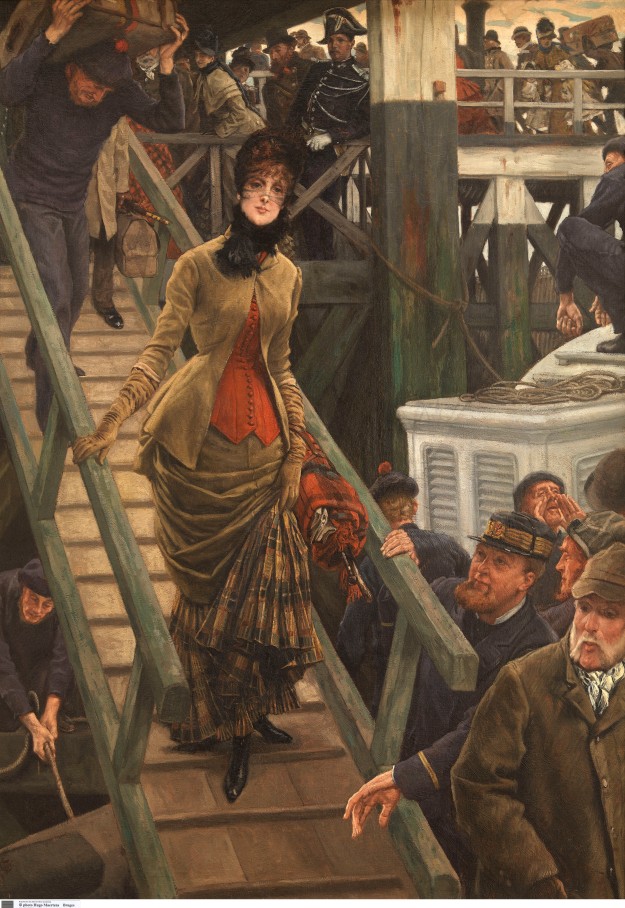
James Joseph Jacques Tissot, Embarkation at Calais, KMSKA, Photo: Hugo Maertens
In this lively scene, a beautiful, fashionable, and confident woman descends a ship’s gangplank unaccompanied, surrounded by fellow travelers, sailors, and laborers. You can hear the shouts and sounds of the dock workers, the thumping footfall of the porter bearing her trunk, and the din of the genteel stampede behind her.

“Goodbye” – On the Mersey (c. 1881), by James Tissot. (Photo: Wikiart.org)
In mid-1871, following the Franco-Prussian War and the bloody days of the Commune, James Tissot moved to London.
Around 1876, he met Kathleen Newton, who moved in with him and became his principal model. Mrs. Newton, a divorcée with two children, died of tuberculosis on November 9, 1882, at age 28, at Tissot’s villa in suburban St. John’s Wood.
Immediately after her funeral on November 14, Tissot returned to Paris, beside himself with grief [see James Tissot’s garden idyll & Kathleen Newton’s death.]
The Embarkation at Calais seems to portray an English woman, connected with his images of Kathleen Newton travelling [see Victorians on the Move, by James Tissot].
In fact, if you look closely just behind the woman’s head, you’ll see a ghostly figure of a woman wearing Mrs. Newton’s distinctive triple-caped greatcoat and high black bonnet. The face is not Kathleen’s though; it’s as if Tissot has put her unforgettable garb on some anonymous stand-in.
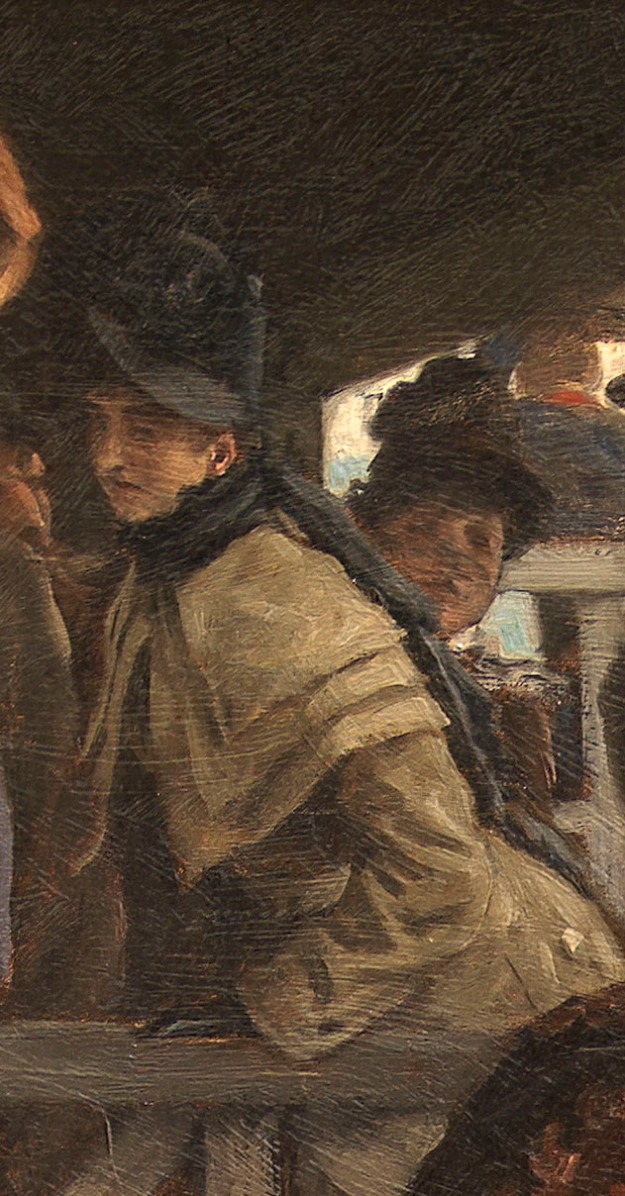

Portrait of Arthur d’Echerac (1883, etching), by Félix Barcquemond.
The Embarkation at Calais was exhibited at Galerie Sedelmeyer, Paris, in 1885. In 1903, about twenty years after Tissot painted it, it was donated to The Royal Museum of Fine Arts, Antwerp by Belgian art collector, art dealer, and critic Paul Leroi (Léon Gauchez 1825-1907).
It is interesting that Leroi, who from 1875 to the year of his death co-published the illustrated weekly magazine, L’art, owned this picture; in 1885, L’art printed an unflattering review of Tissot’s La Femme à Paris series by G. Dargenty [pseudonym of the sculptor, public administrator and art critic Arthur Auguste d’Echérac (1832-1919)] that referred to the central figures as “graceful puppets put into movement on the stage where they are used to performing, who call for neither commentary nor notes, inspire neither admiration nor repugnance nor desires, and are content to be interesting and pleasant to see.”
The Royal Museum of Fine Arts, Antwerp has been closed for renovation since late 2011. Tissot’s painting, displayed in Antwerp, the Netherlands, and Honfleur, France over the past decade and a half, was last exhibited in public in “James Tissot: 1836-1902” (September 26, 2015 – February 21, 2016), held at the Palazzo Montoro in Rome, Italy. Now in storage in the museum’s facility in Kallo, about twenty minutes outside Antwerp in the harbor, it was made available for me to view by the accommodating staff.

My embarkation at Antwerp, in the splendid Central Station (c. 1905)


At first glance, it is an odd picture for Tissot – cheerless, using the thick, dry pigment that characterized his La Femme à Paris series but in a dark palette of browns, greys and blues with touches of burnt sienna for contrast. It’s as if Tissot has lost his direction, attempting to soldier on in the vein of the unsuccessful La Femme à Paris but without the passion that animated that project.
He had left his shining, enameled Academic style behind when he emigrated to England in mid-1871, but in this painting, there is none of the palpable self-confidence, exuberant brushwork, or wit, that characterized his best work throughout the 1870s, and in his remaining years with Kathleen Newton. Yet in its myriad vignettes, Tissot still shows his fascination with individual faces and human emotion. Even dejected and directionless, he can’t create a composition that doesn’t brim with life. This is the quality that Vincent van Gogh described in a letter to his brother, Theo, on September 24, 1880:
“A discerning critic once rightly said of James Tissot, ‘He is a troubled soul.’ However this may be, there is something of the human soul in his work and that is why he is great, immense, infinite…”
The museum staff kindly shared a high-resolution image for this article, so let’s get a good look at some of Tissot’s details.

In his expression, his shoulders and his hands, we can see how the porter strains under his heavy load.

The crowd on the pier is so detailed, it seems copied from a photograph.
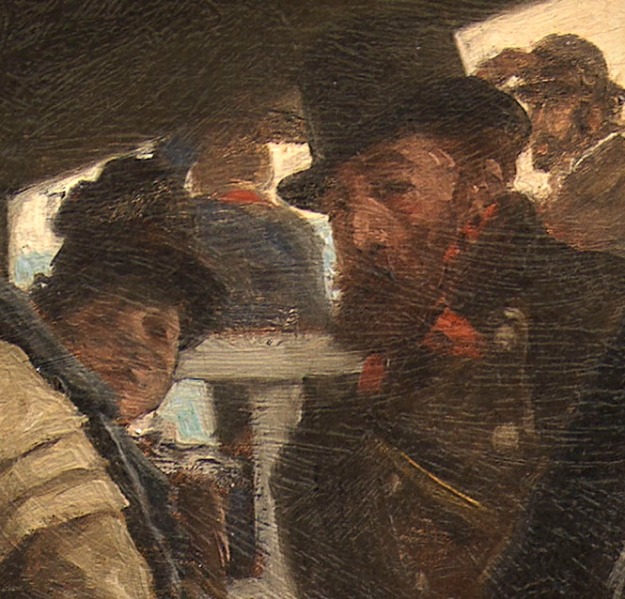
A rather smug-looking couple glances curiously at the central figure – or at us?

A young mother protectively hurries her two little daughters through the throng.

A dock worker squats, his strong hands anticipating the next task.

The captain automatically offers his hand, though the lady is managing well on her own, while the laborers to his right go about their business.

We can tell how loudly this worker must shout to be heard.

Another dock worker quietly concentrates on the job at hand.

We see no heels on the lady’s narrow leather boots, and so she appears to float.
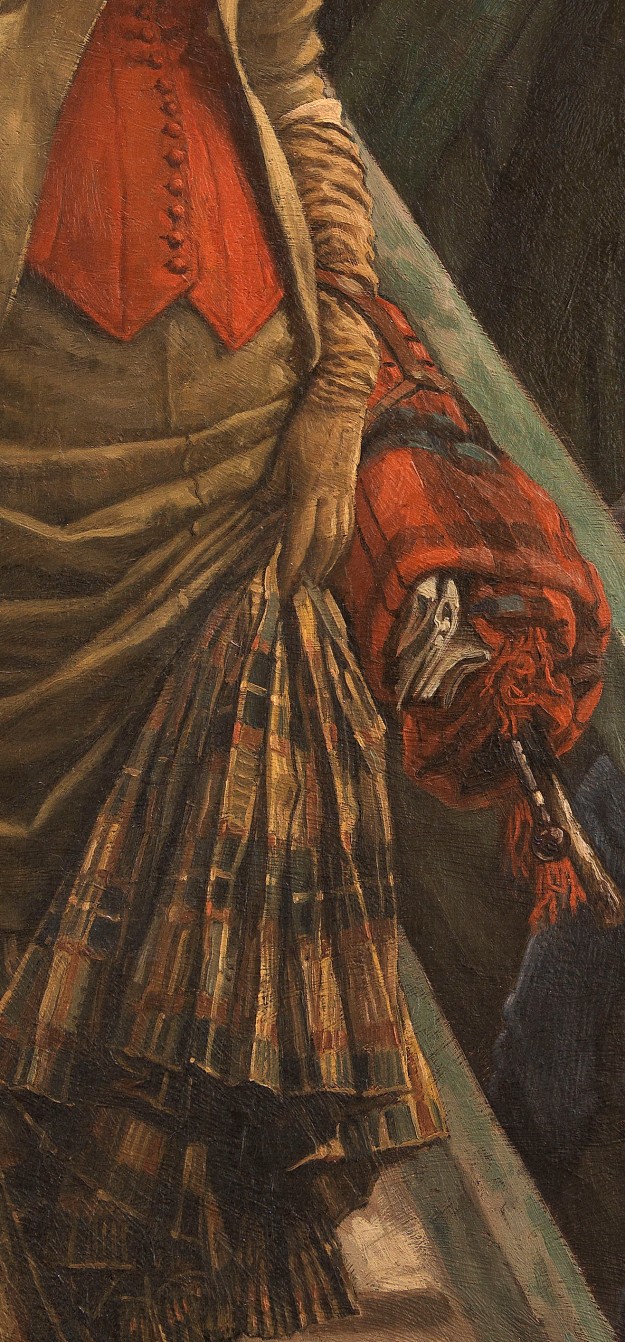
Tissot again demonstrates his love of painting plaid.

The lady’s movement is suggested by the wrinkles in her gloves and the drape of her skirt.
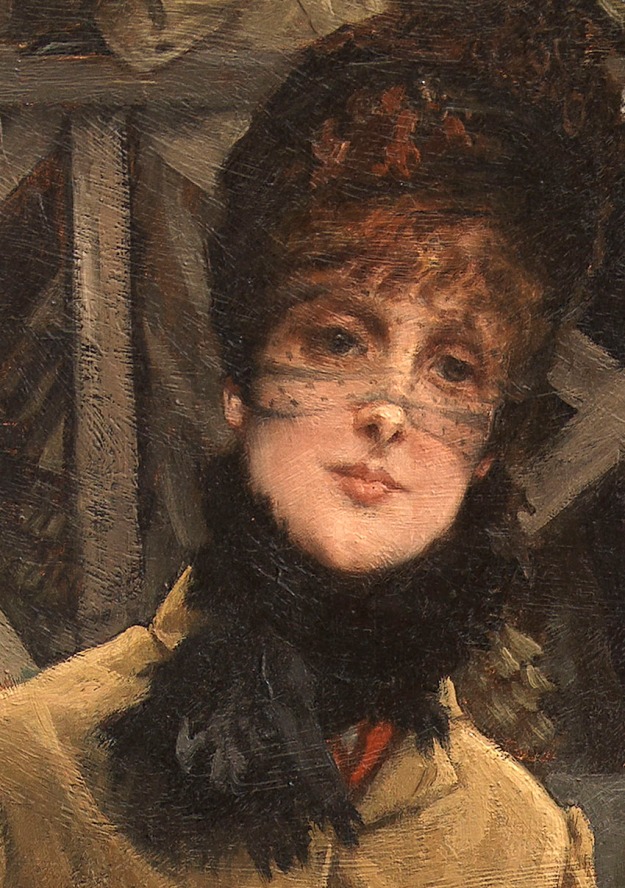
A beautiful face, a self-possessed demeanor.
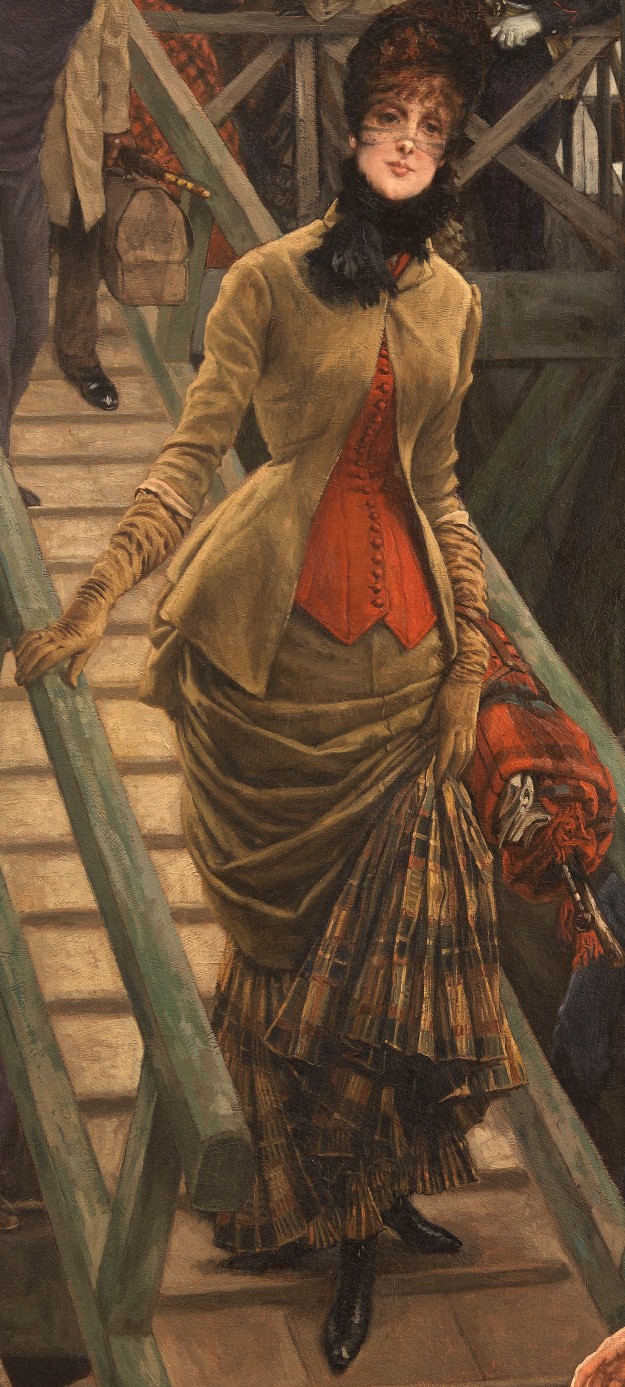
There is something ethereal about this veiled woman, so weightless on those tiny feet, and strangely detached from the humanity surrounding her. Is she alone, or is the mysterious, headless man behind her actually with her? Overall, this is an unexpectedly haunting and somewhat sad painting of what it feels like to be lonely in a crowd of strangers: everyone is busy with their own tasks and emotional life, and not one of these people is engaged with any of the others. There is a strong sense in The Embarkation at Calais that, rather than portraying the life around him, James Tissot was inadvertently portraying his own psychological state at this time, between Kathleen Newton’s death and his imminent, abrupt reincarnation as a Bible illustrator. The Embarkation at Calais is significant in that this was Tissot’s last painting of “modern life.”
With special thanks to the following staff
at Koninklijk Museum voor Schone Kunsten Antwerpen:
Fleur Van Paassen, Registrar
Johan Willems, Depot Manager
Madeleine ter Kuile, Imaging Manager
© 2019 Lucy Paquette. All rights reserved.
The articles published on this blog are copyrighted by Lucy Paquette. An article or any portion of it may not be reproduced in any medium or transmitted in any form, electronic or mechanical, without the author’s permission. You are welcome to cite or quote from an article provided you give full acknowledgement to the author.
Related posts:
James Tissot’s “A Civic Procession” (c. 1879)
Tissot in the U.S.: The Speed Museum, Kentucky
A Closer Look at Tissot’s “The Ball on Shipboard”
A Closer Look: The Circus Lover (The Amateur Circus), by James Tissot
A Closer Look at Tissot’s “Hush! (The Concert)”

The Hammock: A novel based on the true story of French painter James Tissot, brings Tissot’s world from 1870 to 1879 alive in a story of war, art, Society glamour, love, scandal, and tragedy.
Illustrated with 17 stunning, high-resolution fine art images in full color
Courtesy of The Bridgeman Art Library
(295 pages; ISBN (ePub): 978-0-615-68267-9).
See http://www.amazon.com/dp/B009P5RYVE.
NOTE: If you do not have a Kindle e-reader, you may download free Kindle reading apps for PCs, Smartphones, tablets, and the Kindle Cloud Reader to read The Hammock: A novel based on the true story of French painter James Tissot. Read reviews.